Satellite Hyperspectral Mapping of Farmland Soil Organic Carbon in Yuncheng Basin Along the Yellow River, China
Abstract
1. Introduction
- (1)
- Integrate input predictors (satellite hyperspectral data, classical factors, and farmland management factors) into a random forest (RF) model to generate fine-resolution spatial maps of farmland SOC across the study region. Explore the impact of different combinations of soil satellite hyperspectral data and environmental variables on the SOC-prediction accuracy of the model.
- (2)
- Evaluate the prediction accuracy of and uncertainties in the farmland SOC spatial distribution map and investigate the effectiveness of different environmental variables, particularly farmland management, in predicting the farmland SOC across the region.
- (3)
- Conduct RF factorial experiments to determine the associations and relative contributions of five environmental factor categories (farmland management activities, topography, vegetation, climate, and soil) to farmland SOC across the study region. Employ structural equation modeling (SEM) to analyze the direct and indirect influences among these five categories and their constituent factors.
2. Materials and Methods
2.1. Study Area
2.2. Soil Sampling
2.3. Satellite Hyperspectral Data Acquisition
2.4. Extraction of Crop Phenology Data
2.5. Extraction of Cropping Index Data
2.6. Selection of Environmental Covariates
2.7. Random Forest (RF) Modeling
2.8. Random Forest (RF) Factorial Experiments
2.9. Partial Least Squares Structural Equation Modeling
3. Results
3.1. Mapping Soil Organic Carbon Using Satellite Hyperspectral and Environmental Variables
3.2. Spatial Distribution of Crop Phenology
3.3. Spatial Distribution of Cropping Index (CI)
3.4. Spatial Distribution of Farmland Soil Organic Carbon
3.5. Relative Contribution of Environmental Variables
3.6. Driving Factor Analysis of Farmland Soil Organic Carbon and Covariate Determination Using Structural Equation Modeling
4. Discussion
4.1. Comparison of Digital Soil Mapping Models Employed for Assessing Farmland Soil Organic Carbon
4.2. Influence of Environmental Variables on Farmland Soil Organic Carbon (SOC) Mapping
4.3. Direct and Indirect Effects of Environmental Variables on Farmland Soil Organic Carbon
5. Conclusions
Author Contributions
Funding
Data Availability Statement
Conflicts of Interest
Abbreviations
| DSM | digital soil mapping |
| SOC | soil organic carbon |
| SOM | soil organic matter |
| RS | remote sensing |
| Vis-NIR | visible-near infrared |
| RF | random forest |
| SEM | structural equation modeling |
| GF-5 | Geofen 5 |
| WRB | World Reference Base for Soil Resources |
| GPS | geographic positioning system |
| AHSI | Advanced Hyperspectral Imager |
| SNR | signal-to-noise ratio |
| ENVI | Environment for Visualizing Images |
| FOD | fractional-order derivative |
| SCARS | stable competitive adaptive reweighted sampling |
| CRESDA | China Centre for Resources Satellite Data and Application |
| NDVI | normalized difference vegetation index |
| S-G | Savitzky–Golay filtering |
| SOS | start of the growing season |
| EOS | end of the growing season |
| WoSIS | World Soil Information Service |
| DEM | digital elevation model |
| USGS | United States Geological Survey |
| NPP | net primary productivity |
| MODIS | moderate resolution imaging spectroradiometer |
| NASA | National Aeronautics and Space Administration |
| CI | cropping index |
| Irr | irrigation capacity |
| Dra | drainage capacity |
| NF | nitrogen fertilizer application rate |
| ML | machine learning |
| num.trees | number of trees |
| mtry | number of variables tried at each split |
| RF-N | random forest model using only natural variables |
| RF-P | random forest model using natural variables including crop phenology |
| RF-M | random forest model using natural variables (excluding phenology) + farmland management factors |
| RF-A | random forest model using all environmental variables (natural + phenology + farmland management) |
| MAE | mean absolute error |
| RMSE | root mean square error |
| R2 | coefficient of determination |
| SD | standard deviation |
| T | topography |
| V | vegetation |
| C | climate |
| S | soil |
| M | farmland management factors |
| PLS-SEM | partial least squares structural equation modeling |
| FRMM | Fine-Resolution Mapping of Mountain Environment |
| MAT | mean annual temperature |
| MAP | mean annual precipitation |
| EVA | actual evapotranspiration |
| CV | coefficient of variation |
| OK | ordinary kriging |
| SVM | support vector machine |
| MLR | multiple linear regression |
| C:N | carbon-to-nitrogen ratio |
References
- McBratney, A.B.; Stockmann, U.; Angers, D.A.; Minasny, B.; Field, D.J. Challenges for soil organic carbon research. In Soil Carbon; Springer: Cham, Switzerland, 2014; pp. 3–16. [Google Scholar]
- Jenny, H. Factors of Soil Formation: A System of Quantitative Pedology; McGraw-Hill: New York, NY, USA, 1941. [Google Scholar]
- McBratney, A.B.; Santos, M.L.M.; Minasny, B. On digital soil mapping. Geoderma 2003, 117, 3–52. [Google Scholar] [CrossRef]
- Mirzaee, S.; Ghorbani-Dashtaki, S.; Mohammadi, J.; Asadi, H.; Asadzadeh, F. Spatial variability of soil organic matter using remote sensing data. Catena 2016, 145, 118–127. [Google Scholar] [CrossRef]
- Viscarra Rossel, R.A.; Webster, R.; Bui, E.N.; Baldock, J.A. Baseline map of organic carbon in Australian soil to support national carbon accounting and monitoring under climate change. Glob. Change Biol. 2014, 20, 2953–2970. [Google Scholar] [CrossRef]
- Mulder, V.L.; Lacoste, M.; Richer-de-Forges, A.C.; Arrouays, D. GlobalSoilMap France: High-resolution spatial modelling the soils of France up to two meter depth. Sci. Total Environ. 2016, 573, 1352–1369. [Google Scholar] [CrossRef]
- Tian, H.; Zhang, J.; Zheng, Y.; Shi, J.; Qin, J.; Ren, X.; Bi, R. Prediction of soil organic carbon in mining areas. Catena 2022, 215, 106311. [Google Scholar] [CrossRef]
- Chen, S.; Liang, Z.; Webster, R.; Zhang, G.; Zhou, Y.; Teng, H.; Hu, B.; Arrouays, D.; Shi, Z. A high-resolution map of soil pH in China made by hybrid modelling of sparse soil data and environmental covariates and its implications for pollution. Sci. Total Environ. 2019, 655, 273–283. [Google Scholar] [CrossRef] [PubMed]
- Liang, Z.; Chen, S.; Yang, Y.; Zhao, R.; Shi, Z.; Viscarra Rossel, R.A. National digital soil map of organic matter in topsoil and its associated uncertainty in 1980’s China. Geoderma 2019, 335, 47–56. [Google Scholar] [CrossRef]
- Xu, D. Rapid Acquisition of Soil Information and Management Zones Delineation Based on Multi-Source Data Fusion at Field Scale. Ph.D. Thesis, Zhejiang University, Hangzhou, China, 2020. [Google Scholar]
- Abbas, F.; Hammad, H.M.; Ishaq, W.; Farooque, A.A.; Bakhat, H.F.; Zia, Z.; Fahad, S.; Farhad, W.; Cerdà, A. A review of soil carbon dynamics resulting from agricultural practices. J. Environ. Manag. 2020, 268, 110319. [Google Scholar] [CrossRef]
- Yang, L.; Cai, Y.; Zhang, L.; Guo, M.; Li, A.; Zhou, C. A deep learning method to predict soil organic carbon content at a regional scale using satellite-based phenology variables. Int. J. Appl. Earth Obs. Geoinform. 2021, 102, 102428. [Google Scholar] [CrossRef]
- Kumar, N.; Nath, C.P.; Das, K.; Hazra, K.K.; Venkatesh, M.S.; Singh, M.K.; Singh, S.S.; Praharaj, C.S.; Sen, S.; Singh, N.P. Combining soil carbon storage and crop productivity in partial conservation agriculture of rice-based cropping systems in the Indo-Gangetic Plains. Soil Tillage Res. 2024, 239, 106029. [Google Scholar] [CrossRef]
- Weiss, M.; Jacob, F.; Duveiller, G. Remote sensing for agricultural applications: A meta-review. Remote Sens. Environ. 2020, 236, 111402. [Google Scholar] [CrossRef]
- Wu, Z. Research on Spatial Variation and Mechanism of Farmland Soil Organic Carbon in Plains. Ph.D. Thesis, Wuhan University, Wuhan, China, 2022. [Google Scholar]
- Wang, R.; Du, W.; Li, P.; Yao, Z.; Tian, H. High-resolution mapping of cropland soil organic carbon in Northern China. Agronomy 2025, 15, 359. [Google Scholar] [CrossRef]
- Kalaiselvi, B.; Chakraborty, R.; Dharumarajan, S.; Kumar, K.S.A.; Hegde, R. Spatial prediction of soil organic carbon and its stocks using digital soil mapping approach. In Remote Sensing of Soils; Elsevier: Amsterdam, The Netherlands, 2024; pp. 411–428. [Google Scholar]
- Liu, S.; Chen, J.; Guo, L.; Wang, J.; Zhou, Z.; Luo, J.; Yang, R. Prediction of soil organic carbon in soil profiles based on visible–near-infrared hyperspectral imaging spectroscopy. Soil Tillage Res. 2023, 232, 105736. [Google Scholar] [CrossRef]
- Ben-Dor, E.; Banin, A. Near-infrared analysis as a rapid method to simultaneously evaluate several soil properties. Soil Sci. Soc. Am. J. 1995, 59, 364–372. [Google Scholar] [CrossRef]
- Dotto, A.C.; Dalmolin, R.S.D.; ten Caten, A.; Grunwald, S. A systematic study on the application of scatter-corrective and spectral-derivative preprocessing for multivariate prediction of soil organic carbon by Vis-NIR spectra. Geoderma 2018, 314, 262–274. [Google Scholar] [CrossRef]
- Guo, L.; Zhang, H.; Shi, T.; Chen, Y.; Jiang, Q.; Linderman, M. Prediction of soil organic carbon stock by laboratory spectral data and airborne hyperspectral images. Geoderma 2019, 337, 32–41. [Google Scholar] [CrossRef]
- Zhao, X.; Zhao, D.; Wang, J.; Triantafilis, J. Soil organic carbon (SOC) prediction in Australian sugarcane fields using Vis–NIR spectroscopy with different model setting approaches. Geoderma Reg. 2022, 30, e00566. [Google Scholar] [CrossRef]
- Zhang, C.; Li, H.F.; Shen, H.F. Thin–cloud correction of GF–5 AHSI visible–light images by combining statistical information and scattering model. J. Remote Sens. 2020, 24, 368–378. [Google Scholar]
- IUSS Working Group WRB. World Reference Base for Soil Resources 2014, Update 2015; World Soil Resources Reports No. 106; FAO: Rome, Italy, 2015. [Google Scholar]
- Zhang, F.; Zhang, G. Chinese Soil Series: Central and Western Volume, Shanxi Volume; Longmen Books: Beijing, China, 2021. [Google Scholar]
- Hong, Y.; Guo, L.; Chen, S.; Linderman, M.; Mouazen, A.M.; Yu, L.; Chen, Y.; Liu, Y.; Liu, Y.; Cheng, H.; et al. Exploring the potential of airborne hyperspectral image for estimating topsoil organic carbon: Effects of fractional-order derivative and optimal band combination algorithm. Geoderma 2020, 365, 114228. [Google Scholar] [CrossRef]
- Meng, X.; Bao, Y.; Liu, J.; Liu, H.; Zhang, X.; Zhang, Y.; Wang, P.; Tang, H.; Kong, F. Regional soil organic carbon prediction model based on a discrete wavelet analysis of hyperspectral satellite data. Int. J. Appl. Earth Obs. Geoinform. 2020, 89, 102111. [Google Scholar] [CrossRef]
- Li, G.; Gao, X.; Xiao, N.; Xiao, Y. Estimation Soil Organic Matter Contents with Hyperspectra Based on sCARS and RF Algorithms. Chin. J. Lumin. 2019, 40, 1030–1039. [Google Scholar]
- Jin, H.; Peng, J.; Bi, R.; Tian, H.; Zhu, H.; Ding, H. Comparing laboratory and satellite hyperspectral predictions of soil organic carbon in farmland. Agronomy 2024, 14, 175. [Google Scholar] [CrossRef]
- Wu, Z.; Liu, Y.; Han, Y.; Zhou, J.; Liu, J.; Wu, J. Mapping farmland soil organic carbon density in plains with combined cropping system extracted from NDVI time-series data. Sci. Total Environ. 2021, 754, 142120. [Google Scholar] [CrossRef]
- Yang, L.; He, X.; Shen, F.; Zhou, C.; Zhu, A.; Gao, B.; Chen, Z.; Li, M. Improving prediction of soil organic carbon content in croplands using phenological parameters extracted from NDVI time series data. Soil Tillage Res. 2020, 196, 104465. [Google Scholar] [CrossRef]
- Cui, J.; Song, D.; Dai, X.; Xu, X.; He, P.; Wang, X.; Liang, G.; Zhou, W.; Zhu, P. Effects of long-term cropping regimes on SOC stability, soil microbial community and enzyme activities in the Mollisol region of Northeast China. Appl. Soil Ecol. 2021, 164, 103941. [Google Scholar] [CrossRef]
- Takoutsing, B.; Heuvelink, G.B.M. Comparing the prediction performance, uncertainty quantification and extrapolation potential of regression kriging and random forest while accounting for soil measurement errors. Geoderma 2022, 428, 116192. [Google Scholar] [CrossRef]
- He, X.; Yang, L.; Li, A.; Zhang, L.; Shen, F.; Cai, Y.; Zhou, C. Soil organic carbon prediction using phenological parameters and remote sensing variables generated from Sentinel-2 images. Catena 2021, 205, 105442. [Google Scholar] [CrossRef]
- Were, K.; Bui, D.T.; Dick, Ø.B.; Singh, B.R. A comparative assessment of support vector regression, artificial neural networks, and random forests for predicting and mapping soil organic carbon stocks across an Afromontane landscape. Ecol. Indic. 2015, 52, 394–403. [Google Scholar] [CrossRef]
- Mousavi, S.R.; Sarmadian, F.; Angelini, M.E.; Bogaert, P.; Omid, M. Cause-effect relationships using structural equation modeling for soil properties in arid and semi-arid regions. Catena 2023, 232, 107392. [Google Scholar] [CrossRef]
- Adhikari, K.; Hartemink, A.E. Digital mapping of topsoil carbon content and changes in the Driftless Area of Wisconsin, USA. Soil Sci. Soc. Am. J. 2015, 79, 155–164. [Google Scholar] [CrossRef]
- King, A.E.; Blesh, J. Crop rotations for increased soil carbon: Perenniality as a guiding principle. Ecol. Appl. 2018, 28, 249–261. [Google Scholar] [CrossRef]
- Feng, X.; Zhao, X.; Liu, Z.; Zhang, Y.; Gu, Q.; Zhang, J.; Guo, E. Distribution characteristics and influencing factors of soil organic carbon in the riparian zone of Mengjin Section of the Yellow River. J. Henan Agric. Univ. 2024, 58, 635–643. [Google Scholar]
- Shi, J. Characteristics and Driving Mechanism of Soil Organic Carbon Stability in Typical Land Use Types in the Lower Yellow River Alluvial/Sedimentary Areas. Master’s Thesis, Henan University, Kaifeng, China, 2023. [Google Scholar]
- Yang, L.; Song, M.; Zhu, A.; Qin, C.; Zhou, C.; Qi, F.; Li, X.; Chen, Z.; Gao, B. Predicting soil organic carbon content in croplands using crop rotation and Fourier transform decomposed variables. Geoderma 2019, 340, 289–302. [Google Scholar] [CrossRef]
- Silatsa, F.B.T.; Yemefack, M.; Tabi, F.O.; Heuvelink, G.B.M.; Leenaars, J.G.B. Assessing countrywide soil organic carbon stock using hybrid machine learning modelling and legacy soil data in Cameroon. Geoderma 2020, 367, 114260. [Google Scholar] [CrossRef]
- Forkuor, G.; Hounkpatin, O.K.L.; Welp, G.; Thiel, M. High resolution mapping of soil properties using remote sensing variables in south-western Burkina Faso: A comparison of machine learning and multiple linear regression models. PLoS ONE 2017, 12, e0170478. [Google Scholar] [CrossRef]
- Moura-Bueno, J.M.; Dalmolin, R.S.D.; Ten Caten, A.; Dotto, A.C.; Demattê, J.A.M. Stratification of a local VIS-NIR-SWIR spectral library by homogeneity criteria yields more accurate soil organic carbon predictions. Geoderma 2019, 337, 565–581. [Google Scholar] [CrossRef]
- Pouladi, N.; Gholizadeh, A.; Khosravi, V.; Borůvka, L. Digital mapping of soil organic carbon using remote sensing data: A systematic review. Catena 2023, 232, 107409. [Google Scholar] [CrossRef]
- Wang, B.; Waters, C.; Orgill, S.; Gray, J.; Cowie, A.; Clark, A.; Liu, D.L. High-resolution mapping of soil organic carbon stocks using remote sensing variables in the semi-arid rangelands of eastern Australia. Sci. Total Environ. 2018, 630, 367–378. [Google Scholar] [CrossRef] [PubMed]
- Hobley, E.; Wilson, B.; Wilkie, A.; Gray, J.; Koen, T. Drivers of soil organic carbon storage and vertical distribution in Eastern Australia. Plant Soil 2015, 390, 111–127. [Google Scholar] [CrossRef]
- Zhu, H.; Bi, R.; Duan, Y.; Xu, Z. Scale-location specific relations between soil nutrients and topographic factors in the Fen River Basin, Chinese Loess Plateau. Front. Earth Sci. 2017, 11, 397–406. [Google Scholar] [CrossRef]
- Wu, J.; Pan, J.; Ge, X.; Wang, H.; Yu, W.; Li, B. Variations of soil organic carbon mineralization and temperature sensitivity under different land use type. J. Soil Water Conserv. 2015, 29, 130–135. [Google Scholar]
- Tian, H.; Liu, S.; Zhu, W.; Zhang, J.; Zheng, Y.; Shi, J.; Bi, R. Deciphering the drivers of net primary productivity of vegetation in mining areas. Remote Sens. 2022, 14, 4177. [Google Scholar] [CrossRef]
- Jing, Y.; Bi, R.; Sun, W.; Zhu, H.; Ding, H.; Jin, H. Whether wheat-maize rotation influenced the change of soil organic carbon in Sushui River Basin. Land 2024, 13, 859. [Google Scholar] [CrossRef]
- Giacometti, C.; Mazzon, M.; Cavani, L.; Triberti, L.; Baldoni, G.; Ciavatta, C.; Marzadori, C. Rotation and fertilization effects on soil quality and yields in a long term field experiment. Agronomy 2021, 11, 636. [Google Scholar] [CrossRef]
- Sena, K.L.; Yeager, K.M.; Barton, C.D.; Lhotka, J.M.; Bond, W.E.; Schindler, K.J. Development of mine soils in a chronosequence of forestry-reclaimed sites in eastern Kentucky. Minerals 2021, 11, 422. [Google Scholar] [CrossRef]

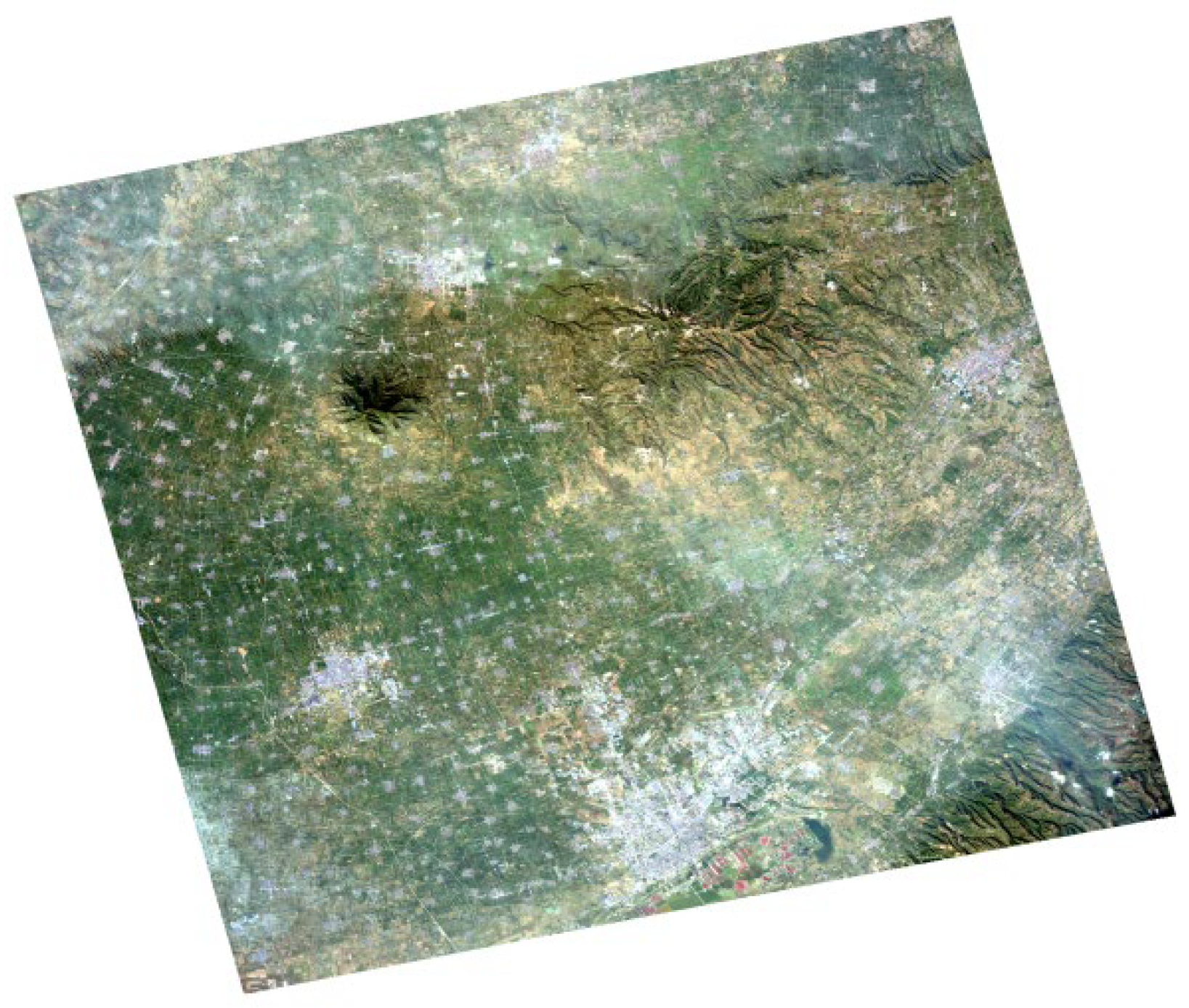

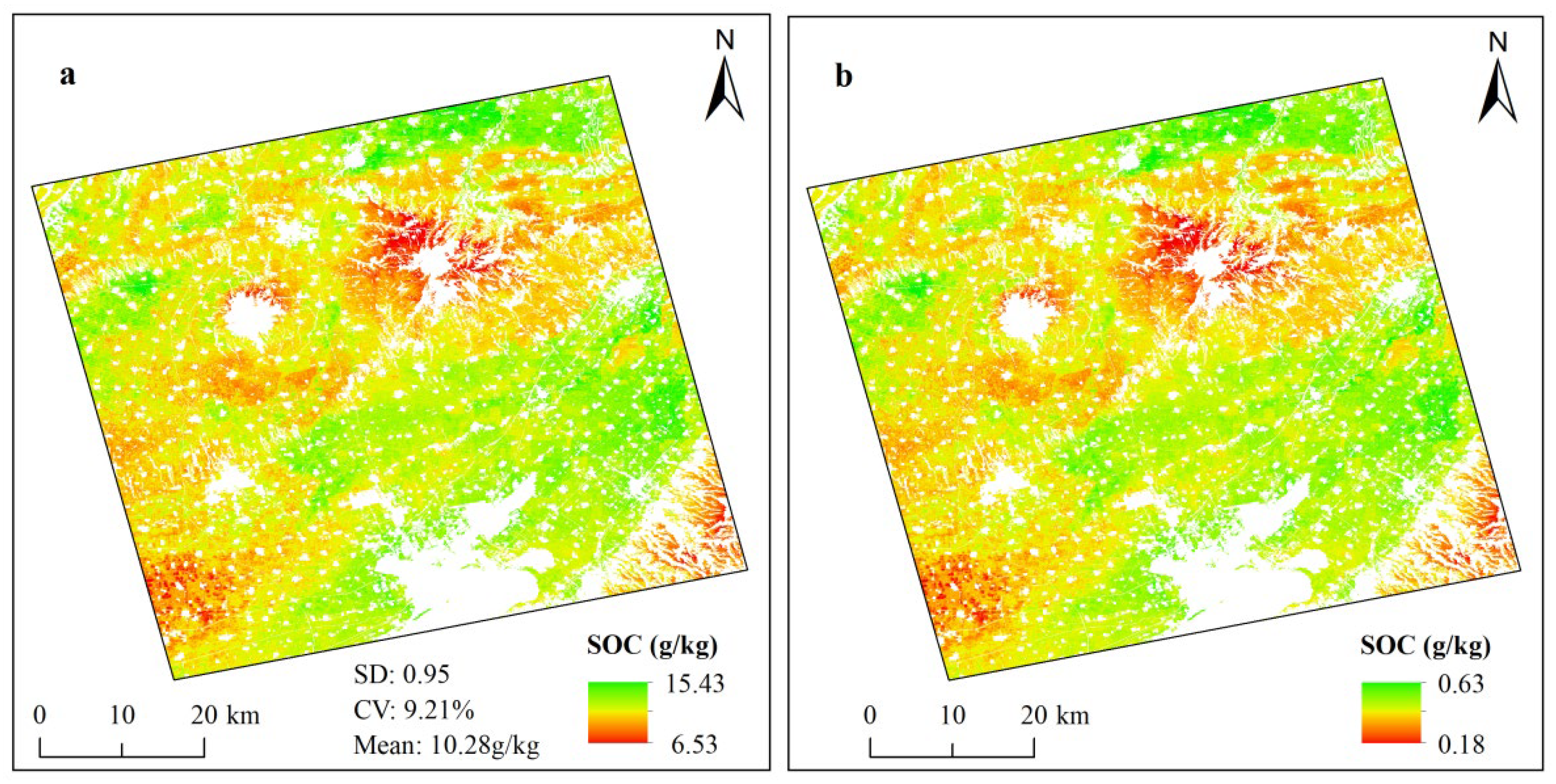

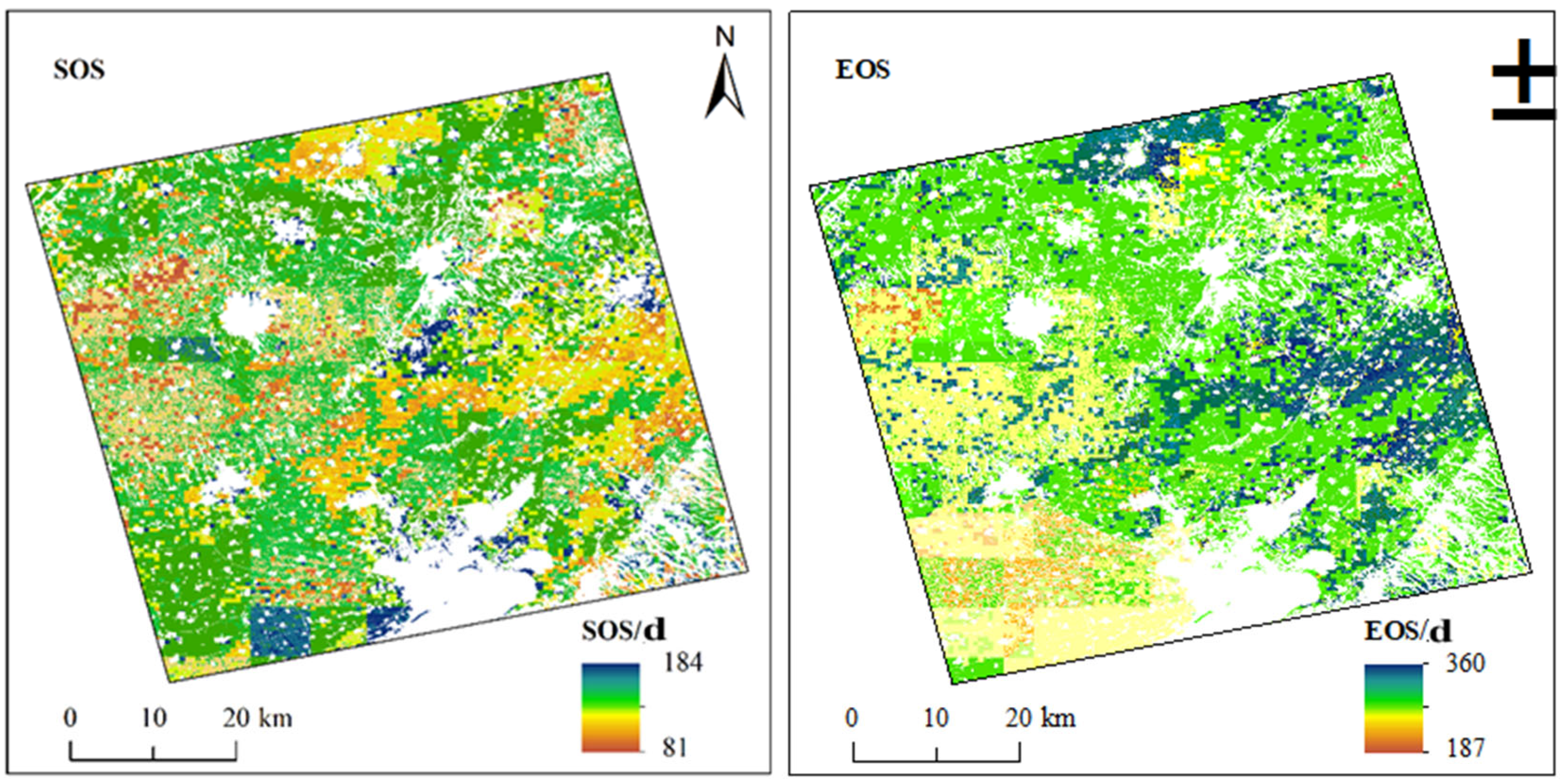
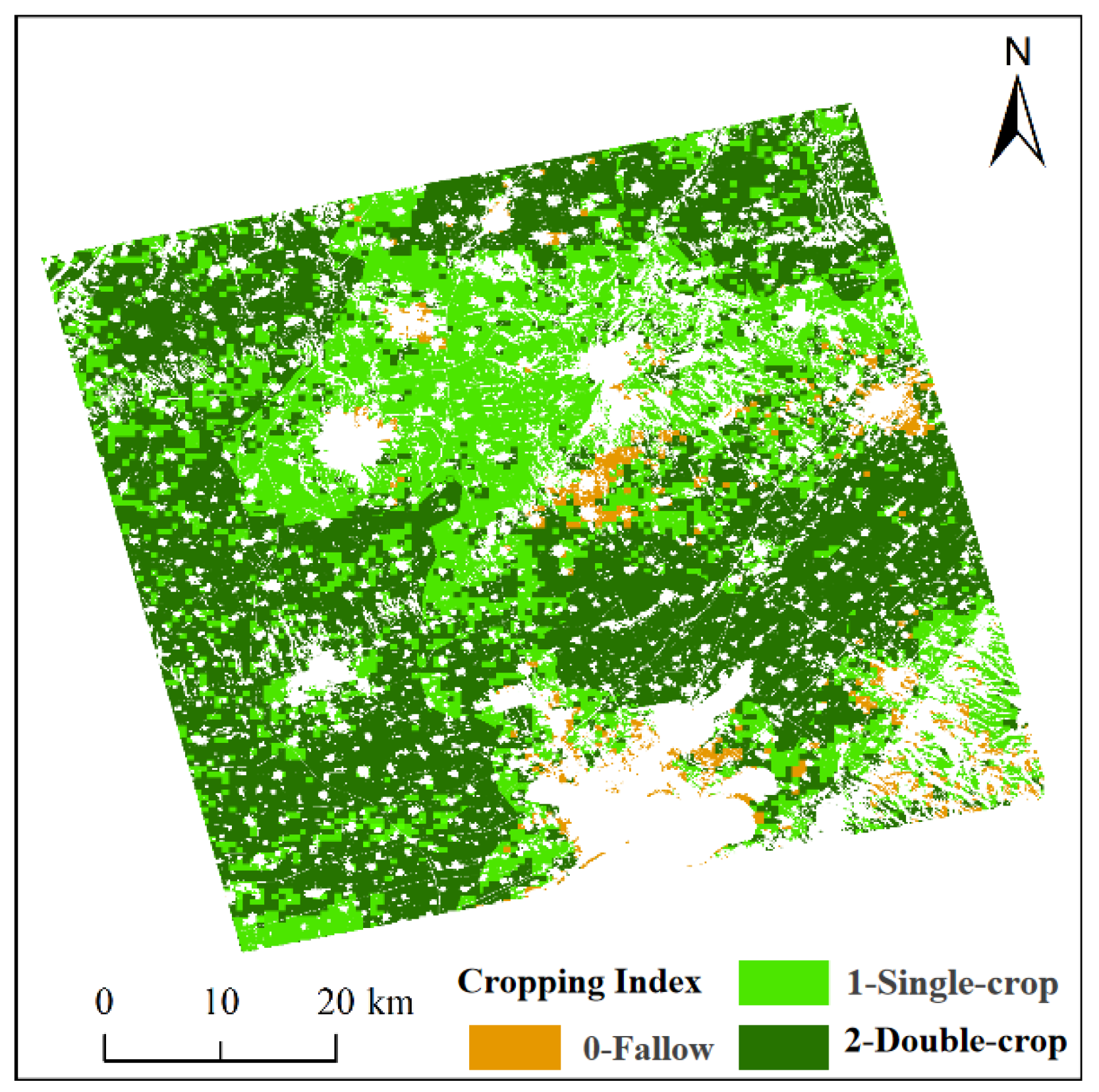
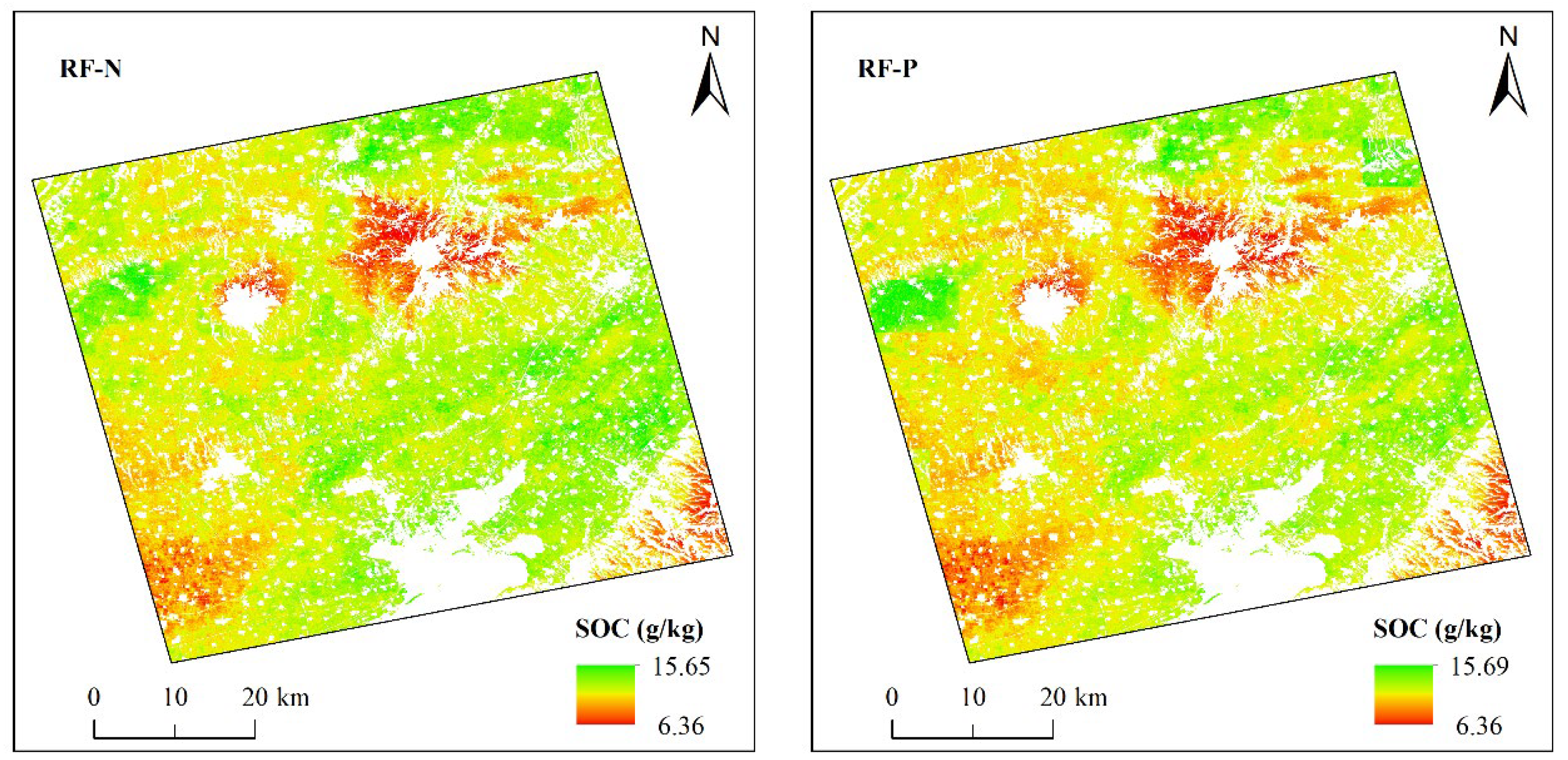
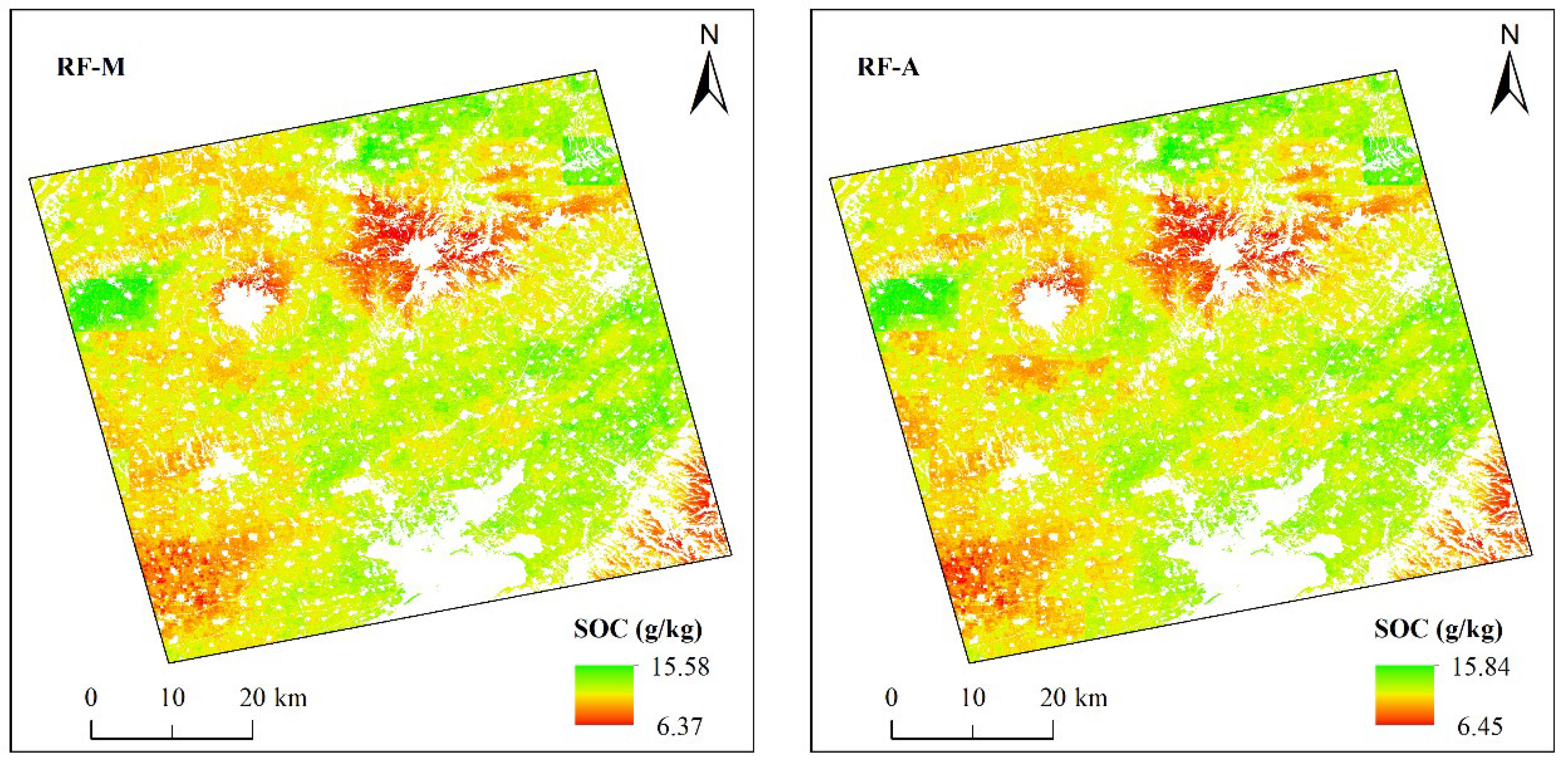



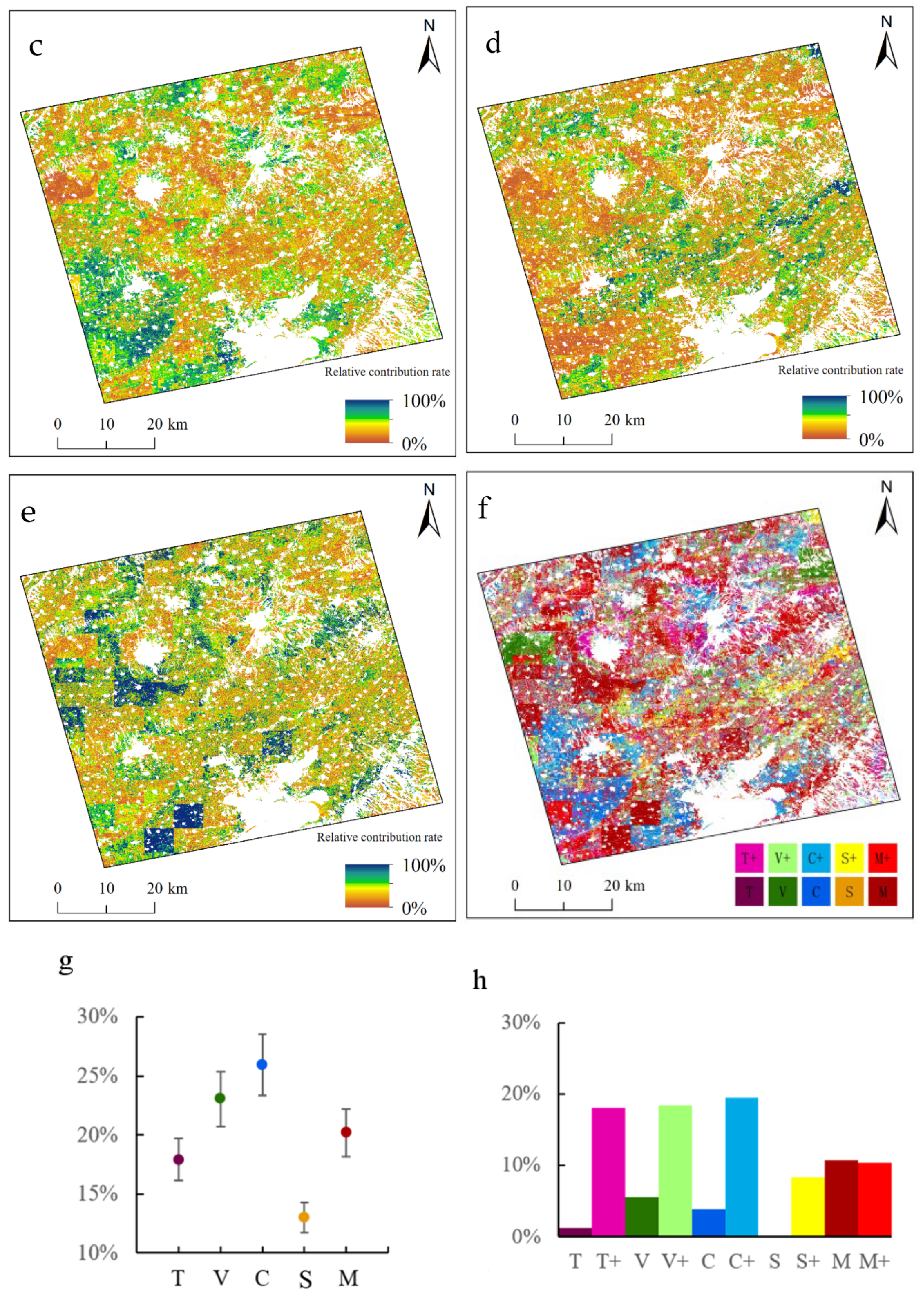
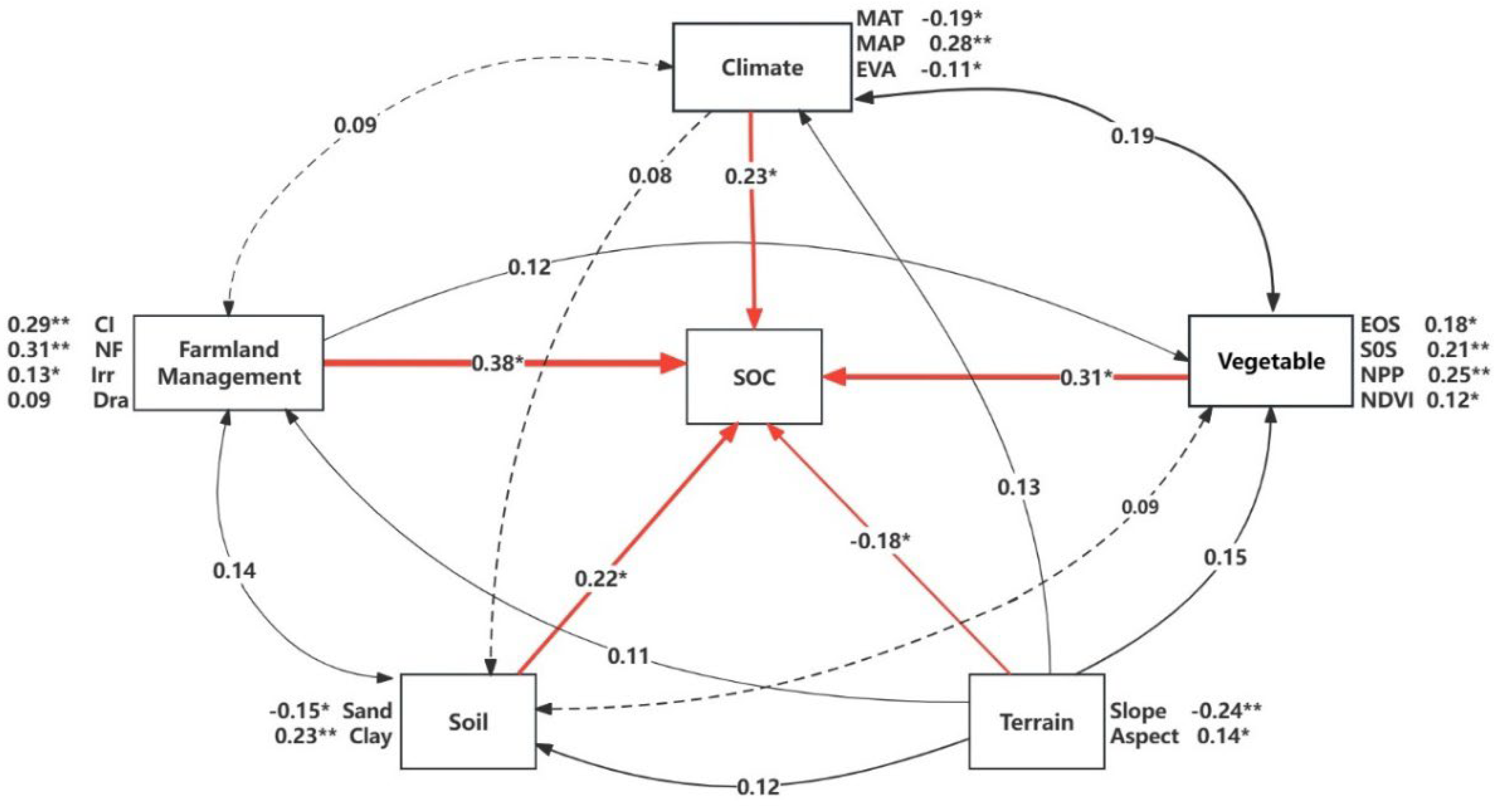
| Environmental Category | Environmental Variable | Unit | Data Source |
|---|---|---|---|
| Topography | Slope | ° | Derived from DEM data (30 m × 30 m) |
| Aspect | ° | ||
| Soil | Sand | % | ISRIC SoilGrids (1:1,000,000; 250 m × 250 m) |
| Clay | % | ||
| Climate | Mean annual temperature (MAT) | °C | FRMM (30 m × 30 m) |
| Mean annual precipitation (MAP) | mm | ||
| Actual evapotranspiration (EVA) | mm | ||
| Vegetation | Normalized difference vegetation index (NDVI) | index values | Resource and Environment Data Center, CAS (30 m × 30 m) |
| Net primary productivity (NPP) | gC·m−2 | MODIS MOD17 Annual NPP Product, NASA (250 m × 250 m) | |
| Start of the growing season (SOS) | day | Extracted from NDVI timeseries remote sensing data | |
| End of the growing season (EOS) | day | ||
| Farmland Management | Irrigation capacity (Irr) | index values | Field surveys (2020); Rasterized in ArcGIS 10.8 (30 m × 30 m) |
| Drainage capacity (Dra) | index values | ||
| Nitrogen fertilizer application rate (NF) | gNm−2 | National Ecological Data Center (resolution of 5 km) | |
| Cropping index (CI) | % | Identified via peak detection in NDVI time series curves |
| Number of Samples | Maximum (g/kg) | Minimum (g/kg) | Mean (g/kg) | Median (g/kg) | Standard Deviation (SD: g/kg) | CV (%) |
|---|---|---|---|---|---|---|
| 312 | 19.20 | 1.42 | 9.96 | 9.82 | 2.98 | 29.92 |
| Cropping Index | Producer’s Accuracy (%) | |||
|---|---|---|---|---|
| Fallow | Single-Crop | Double-Crop | ||
| Fallow | 19 | 4 | 1 | 79.16 |
| Single-crop | 2 | 75 | 6 | 90.36 |
| Double-crop | 4 | 10 | 192 | 93.20 |
| User’s Accuracy (%) | 76.00 | 84.26 | 96.48 | |
| Overall Accuracy: 88.77%; Kappa Coefficient: 0.8012 | ||||
| Model | Max (g/kg) | Min (g/kg) | Mean (g/kg) | SD (g/kg) | CV (%) | R2 | RMSE (g/kg) | MAE (g/kg) |
|---|---|---|---|---|---|---|---|---|
| RF-N | 15.65 | 6.36 | 10.35 | 0.97 | 9.37 | 0.78 | 1.40 | 0.52 |
| RF-P | 15.69 | 6.36 | 10.36 | 1.02 | 9.84 | 0.81 | 1.37 | 0.49 |
| RF-M | 15.78 | 6.37 | 10.13 | 1.02 | 10.07 | 0.87 | 1.22 | 0.43 |
| RF-A | 15.84 | 6.45 | 10.07 | 1.04 | 10.33 | 0.89 | 1.14 | 0.41 |
Disclaimer/Publisher’s Note: The statements, opinions and data contained in all publications are solely those of the individual author(s) and contributor(s) and not of MDPI and/or the editor(s). MDPI and/or the editor(s) disclaim responsibility for any injury to people or property resulting from any ideas, methods, instructions or products referred to in the content. |
© 2025 by the authors. Licensee MDPI, Basel, Switzerland. This article is an open access article distributed under the terms and conditions of the Creative Commons Attribution (CC BY) license (https://creativecommons.org/licenses/by/4.0/).
Share and Cite
Jin, H.; Bi, R.; Tian, H.; Zhu, H.; Jing, Y. Satellite Hyperspectral Mapping of Farmland Soil Organic Carbon in Yuncheng Basin Along the Yellow River, China. Agronomy 2025, 15, 1827. https://doi.org/10.3390/agronomy15081827
Jin H, Bi R, Tian H, Zhu H, Jing Y. Satellite Hyperspectral Mapping of Farmland Soil Organic Carbon in Yuncheng Basin Along the Yellow River, China. Agronomy. 2025; 15(8):1827. https://doi.org/10.3390/agronomy15081827
Chicago/Turabian StyleJin, Haixia, Rutian Bi, Huiwen Tian, Hongfen Zhu, and Yingqiang Jing. 2025. "Satellite Hyperspectral Mapping of Farmland Soil Organic Carbon in Yuncheng Basin Along the Yellow River, China" Agronomy 15, no. 8: 1827. https://doi.org/10.3390/agronomy15081827
APA StyleJin, H., Bi, R., Tian, H., Zhu, H., & Jing, Y. (2025). Satellite Hyperspectral Mapping of Farmland Soil Organic Carbon in Yuncheng Basin Along the Yellow River, China. Agronomy, 15(8), 1827. https://doi.org/10.3390/agronomy15081827





